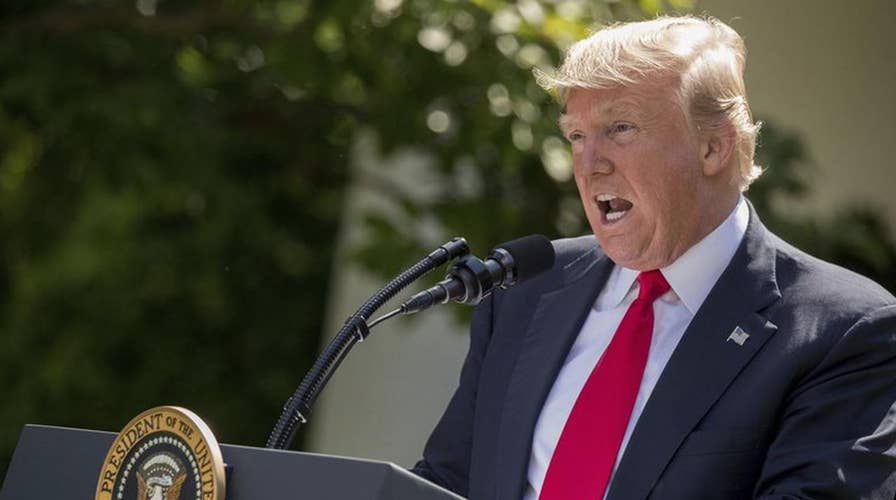Trump vs. global elites; says he's putting US workers first
Shouldn't the president look out for American taxpayers?
Perhaps it’s only appropriate that there’s a geographical common denominator between the U.S.’s first international agreement and the climate-related pact from which the U.S. most recently withdrew: Paris.
The 1783 Treaty of Paris between Great Britain and the ascendant United States halted the Revolutionary War and set into motion the American experiment. The first article of the treaty granted the U.S. the right to exist as a sovereign nation, liberated from the British. The U.S.’s Congress of the Confederation (created between the first and second Continental congresses and prior to the inception of the modern U.S. Congress) ratified the treaty in 1784.
In other words, the concept of international treaties predates the republic. The Founders incorporated the idea of treaties into the Constitution. Article II, Section 2 grants the president power “with the Advice and Consent of the Senate, to make Treaties, provided two thirds of the Senators present concur.”
This is why President George Washington personally called on the Senate in 1790 to seek advice and consent when trying to hammer out an accord with the Creek Indians.
But over the past 227 years, presidential administrations rarely go by the book when forging international accords.
Getting over the two-thirds bar for ratification in the Senate is a challenge. The Constitution leaves the House out of the picture altogether when it comes to treaties. So when presidents draft international pacts these days, they frequently write them in a way so they aren’t considered a “treaty” worthy of Senate consideration. If a Capitol Hill lawmaker howls about being left out of the process, the White House and congressional leaders from both parties often assemble some sort of legislative “framework,” which entails the approval by both chambers of Congress -- and certainly not requiring two-thirds for adoption.
Consider recent, major international agreements into which the U.S. entered: The North American Free Trade Agreement (NAFTA) wasn’t a “treaty.” The House and Senate voted on that.
The same with the Central American Free Trade Agreement (CAFTA). Former President Barack Obama acquiesced to the demands of Congress for provisional House and Senate “consideration” of the Iran nuclear agreement. Senate Foreign Relations Committee Chairman Bob Corker, R-Tenn., wrote legislation that didn’t necessarily approve or reject the Iran plan. It simply engineered a “review” process and bolstered the ability of Congress to sanction Tehran.
The same was true in 2015 when Obama tried to score the congressional blessing for a major trade package known as the Trans-Pacific Partnership (TPP). Congress stumbled first to adopt a structure to ratify TPP (not as a treaty). The House and Senate underwent serious parliamentary gymnastics to advance Trade Promotion Authority (TPA) and Trade Adjustment Assistance (TAA).
The latter served as sidebar that the Obama Administration thought was essential to score some Democratic support. The House argued it was crucial to consider the plans separately. The Senate needed them melded as one. After a major hiccup in the House, the Senate restructured the parliamentary gambit just to lug both across the finish line.
In the end, neither the House nor Senate ever considered the underlying agreement, the Trans-Pacific Partnership. President Trump formally withdrew from TPP earlier this year.
Would it have been easier treating TPP as a traditional treaty and dealing with just the Senate? Maybe. But obtaining ratification with 67 votes? Doubtful.
This backstory brings us to the 2015 United Nations Climate Change Conference held in Paris. It’s sometimes referred to as COP 21 (short for Conference of the Parties). The key provision of the Paris agreement was to curb global warming by 1.5 degrees Celsius prior to temperatures at the start of the Industrial Revolution.
The Obama administration didn’t submit the plan to the Senate as a conventional treaty. French Foreign Minister Laurent Fabius argued signers must agree to “a formula which is valuable for everybody and valuable for the U.S. without going to Congress.”
This is why Obama hoped to bypass Congress -- in any form -- with the Paris agreement. There’s a lot of debate about what constitutes a treaty that must head to the Senate. The State Department long ago drafted procedures to determine what qualifies as a treaty, known as “Circular 175.” Circular 175 runs through a series of eight tests about the impact an agreement has on the U.S., its duration and how the accord affects states.
One of the tests includes a desire of lawmakers from both chambers to weigh-in on an international agreement. But this is all up to interpretation. And facing a hostile, Republican House and Senate, Obama knew it was unlikely he’d find much support on Capitol Hill. So he simply inked the deal for the U.S. with an executive order last autumn.
Without congressional sign-off, this calls into question whether the U.S. was ever formally “in” the Paris agreement.
And as recent history has shown, the U.S. has elected to “join” international agreements via legislative votes in both the House and Senate, rather than following the Founders prescribed method of submitting a treaty to the Senate for the advice and consent of 67 senators.
This is the latest incident in a growing trend of bypassing the Senate and the provisions dictated in Article II, Section 2 of the Constitution.
Without congressional authorization in any form, some could argue just how deeply the U.S. was involved with the Paris climate agreement. But the U.S. is now out. A strict reading of the Constitution would question whether the U.S. qualified as a signatory.
It’s clear the Founders wanted to grant latitude to the executive branch to negotiate treaties. But the two-thirds bar for advice and consent was critical to have buy-in from at least one chamber of the legislative branch.
Now back to the Treaty of Paris, which launched the entire American enterprise. John Adams, Ben Franklin and John Jay negotiated the terms of the treaty on behalf of the incipient United States. It then went to the U.S.’s nominal legislative authority for ratification.
The U.S. has been in the original Paris agreement since the start. It’s unclear if the U.S. was ever “in” the latest Paris agreement at all.





